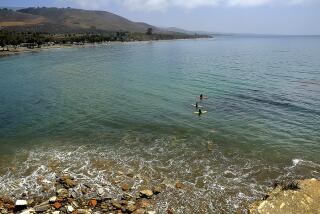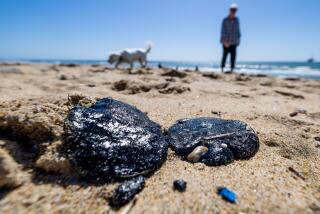105,000 gallons of oil may have spilled in Santa Barbara County
Reporting From Santa Barbara — The operator of an underground pipeline that ruptured and released up to 105,000 gallons of crude oil in Santa Barbara County -- and tens of thousands of gallons into the ocean -- said Wednesday that the spill happened after a series of mechanical problems caused the line to be shut down.
The problems began about 10:45 a.m. Tuesday at two pump stations that move oil through the 11-mile pipeline along the Gaviota Coast, Rick McMichael, director of pipeline operations for Plains All American Pipeline, said at a news conference.
The company said its estimate of 105,000 gallons spilled west of Santa Barbara is a worst-case scenario that was based on the line’s elevation and flow rate -- which averages about 50,400 gallons an hour.
Investigators won’t find a cause for the rupture until they excavate the 24-inch wide line, which was installed in 1987, according to a joint statement from government and company officials.
When the line ruptured Tuesday, the oil seeped through the ground to a culvert and flowed into the ocean about a mile up the coat from Refugio State Beach. The company estimates about 21,000 gallons of crude went into the water.
The U.S. Coast Guard said a pair of oil slicks are stretching across a combined nine miles.
The California Department of Fish and Wildlife said it had crews combing the beaches in search of oiled wildlife but that the agency did not yet have a count of how many have been affected.
At least two brown pelicans were oiled by the spill, said Jim Milbury, a spokesman for NOAA Fisheries. So far, federal wildlife officials have found no marine mammals affected, he said.
Photographer Reeve Woolpert, 69, of Summerland came down from Refugio to an area near the spill and saw a brown pelican by the shore covered in oil.
He told fish and wildlife and state parks officials about the bird, but three hours later nobody had come by.
“I said this bird wants to live, it’s a fighter,” Woolpert said.
So he wrapped the bird in his T-shirt and climbed the bluffs up to the train tracks where the spill first crossed toward the ocean.
A fish and wildlife worker came and took the blackened bird away in a cardboard box.
As Woolpert stood in a children’s sized swimming pool and scrubbed the oil off himself with a rag and soap, he looked down at the pooled oil from the culvert.
“It is a damn shame,” he said.
Also on Wednesday, Gov. Jerry Brown declared a state of emergency for Santa Barbara County to free up resources to respond to the spill.
The ruptured line, owned by Houston-based Plains All American Pipeline, is part of a larger oil transport network centered in Kern County.
An integrity check on the line was done two weeks ago, but results had not come back before Tuesday’s rupture, said Darren Palmer, district manager for Plains All American. The last inspection prior to this month was in 2012, according to the company.
The line was manually shut down by 11:30 a.m. after company workers noticed pressure abnormalities, company officials said. But the rupture was not confirmed visually until two hours later, when a company employee went to the site to inspect a report of an odor.
“We’re sorry this accident has happened, and we’re sorry for the inconvenience to the community,” Palmer said at the news conference.
Fishing and shellfish harvesting have been closed for one mile on either side of Refugio Beach, a popular coastal campsite, state officials said.
The Santa Barbara County Office of Emergency Management estimated it could take at least three days to clean up the spill, but that it will likely take much longer.
State park officials have shut down both Refugio and nearby El Capitan State Beach for the weekend and urged volunteers eager to head to the coast to clean to stay away while the investigation and recovery is ongoing.
The U.S. Coast Guard is supervising the cleanup effort, officials said. Plains All American hired Patriot Environmental Services, which was involved in the Deepwater Horizon oil spill cleanup effort in the Gulf of Mexico in 2010, to manage the cleanup.
The company is using skimmers and booms to soak and suck up the oil and have already recovered more than 6,000 gallons, Plains All American officials said.
On Wednesday, workers in white protective suits, white helmets and yellow boots were working along several hundred yards of beach, doing the arduous work of shoveling fouled mud into clear plastic bags.
Occasionally a few formed human chains, passing the heavy bags from hand to hand to be piled near a parking area for pickup.
“This stretch of the California coast is unique in the world,” Santa Barbara County Supervisor Doreen Farr, who represents the area where the spill occurred, said at the news conference. “This is more than an inconvenience, this is a disaster.”
Linda Krop, chief counsel for the Santa Barbara-based Environmental Defense Center, visited Refugio State Beach late Tuesday and said she was alarmed to find little response to the spill.
“There was oil that was covering the beach and also being washed out to sea,” she said. “To me this was a very significant event. The beach was just blanketed in black tar.”
She said there was little active response to the spill.
Krop said the spill was particularly alarming because it was the result of a ruptured pipeline, which are considered safer than other modes of transporting oil, such as tankers.
“This spill happened from a pipeline that was built with supposed safeguards,” she said. “Pipelines tend to be a safer ... but even a pipeline can leak and rupture and cause a really significant spill.”
Krop was worried about how far the slick would spread through the Santa Barbara Channel, which she called “one of the most biologically rich places on the planet.”
“Right now we have migratory whales, including endangered humpbacks and blue whales,” she said. “We also have gray whales migrating back from Baja [California] to Alaska, and they come closer to shore. We also have a lot of very rare seabirds and other coastal endangered species. It’s a very, very sensitive, important place and we don’t know what the eventual harm will be.”
But farther south, county tourism officials said a yacht race planned for the weekend off Santa Barbara would go on as scheduled because the oil wasn’t expected to spread that far.
During the several-hours-long leak, about 21,000 gallons of oil escaped the pipeline, Coast Guard officials estimated. Coast Guard crews stopped the leak by 3 p.m., said Petty Officer Andrea Anderson.
The Santa Barbara County district attorney’s office was investigating the incident for any potential criminal or civil liabilities, said Dist. Atty. Joyce Dudley.
California State Parks district superintendent Richard Rozzelle said officials were assessing the spill’s impact by helicopter.
“We are very disappointed to have oil on our beach,” Rozzelle said Wednesday, standing near oil-covered rocks. “It is a public resource we spend a lot of time protecting.”
The executive director of Audubon California, Brigid McCormack, said, “Anytime you have oil spilled into the marine ecosystem, it’s a major threat for birds and other wildlife.”
“California’s beaches, including the wildlife and recreational opportunities they support, are a major part of our state’s identity,” McCormack said. “Time and time again, we’re reminded that the benefits of putting oil so close to our natural treasures are never worth the risk.”
For breaking news in California, follow @JPanzar and @JosephSerna.
Panzar and Barboza reported from Santa Barbara and Serna from Los Angeles.
ALSO:
Central Valley’s growing concern: Crops raised with oil field water
Oil spill cleanup makes Refugio State Beach look more like a MASH unit
Op-Ed: 5 years after BP spill, little has changed to protect Gulf of Mexico
More to Read
Sign up for Essential California
The most important California stories and recommendations in your inbox every morning.
You may occasionally receive promotional content from the Los Angeles Times.














